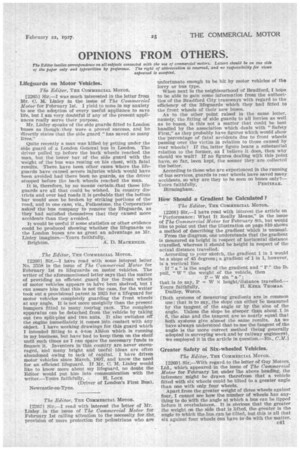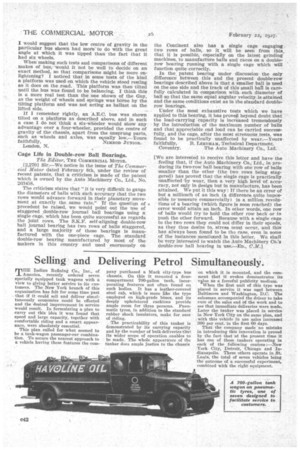OPINIONS FROM OTHERS.
Page 63

Page 64

If you've noticed an error in this article please click here to report it so we can fix it.
The Editor invites correspondence on all subjects connected with the use of commercial motors; Letters should be on one side of the paper only and typewritten by preference. The right of abbreviation is reserved, and no responsibility for views
expressed is accepted.
Lifeguards on Motor Vehicles.
The Editor, THE COMMERCIAL MOTOR.
[2265] Sir, —I was much interested in the letter from Mr. C. M. Linley in the issue of The Commercial Motor for February 1st. I yield to none in my anxiety to see the adoption of every useful appliance to save life, but I am very doubtful if any of the present appliances really serve their purpose.
Mr. Linley speaks of the side guards fitted to London buses as though. they were a proved success, and he directly states that the side guard "has saved so many lives."
Quite recently a man was killed by getting under the side guard of a London General bus in London. The driver pulled up before the back wheels reached the man, but the lower bar of the side guard with the weight of the bus was resting on his chest, with fatal results. There have been other cases Where the lifeguards have caused severe injuries which would have been avoided had there been no guards, as the driver stopped before the back wheels reached the man.
It is, therefore, by no means certain that these lifeguards are all that could be wished. In country districts and over bad roads it is probable that the bottom bar would soon be broken by striking portions of the road, and in one case, viz., Folkestone, the Corporation' asked the bus company to remove the lifeguards, as they had satisfied themselves. that they caused more accidents than they avoided.
It would be useful if some statistics or other evidence could be produced showing whether the lifeguards on the London buses are as great an advantage as Mr. Linley imagines.—Yours faithfully, Brighton. A. D. MACKENZIE.
The Editor, TEE Commsaukt MOTOR.
[22661 Sir, —I have read with some interest letter No. 2558 in the issue of The Commercial Motor for February 1st re lifeguards on motor vehicles. The writer of the aforementioned letter says that the matter of providing an efficient guard for the front wheels of motor vehicles appears to have been shelved, but I can assure him that this is not the case, for the writer took out a provisional patent in 1925 for a lifeguard for motor vehicles completely guarding the front wheels at any angle. It is not more unsightly than the present bumpers fitted to many touring ears. The complete apparatus can be detached from the vehicle by taking out two split-pinsand two nuts. It also switahes off the engine immediately it comes into contact with any object. I have working drawings for this guard which I intended fitting to a 4-ton Albion which is running in my business, but have had to keep them on the shelf -until such times as I can spare the necessary funds to finance it. Inventors in this country are never encouraged, and many bright and useful ideas are often abandoned owing to lack of capital. I have driven motor vehicles since March, 1897, and know the need for an efficient lifeguard. If Mr. C. M. Linley would like to know more about my lifeguard, no doubt the Editor would put him into communication -with the
writer. —Yours faithfully, H. LOCK (Driver of London's First Bus).
Newcastle-on-Tyne.
The Editor, THE COMMERCIAL MOTOR.
[2-2671 Sir, —I read with interest the letter of Mr. Llnley in the issue of The Commercial Motor for February 1st calling attention to the necessity for the provision of more protection for pedestrians mrho are
unfortunate enough to be hit by motor vehicles of the lorry or bus type.
When next in the neighbourhood of Bradford, I hope to be able to gain some information from the authorities of the Bradford City tramways with regard to the efficiency of the lifeguards which they had fitted to the front wheels of their new buses.
As to the other point raised in the same letter, namely, the fitting of side guards to all lorries as well as to buses, is this not a matter that could be best. handled by the association which deals with "Safety First," as they probably have figures which would show the percentage of fatal accidents due to front wheels passing over the victim in relation to those caused by rear wheels? If the, latter figure bears a substantial relation to the former, as I believe it does, then why should we wait? If no figures dealing with this point have, so far, been kept, the sooner they are collected the better.
According to those who are experienced in the running of bus services, guards to rear wheels have saved many accidents, so why are they to be seen on buses only?—
Yours faithfully, PERTINAN. Birmingham.
HOw Should. a Gradient be Calculated ?
The Editor, TH.E COMMERCIAL MOTOR.
[2208] Sir—I have read with interest the article on " Performance: What It Really Means," in the issue of The Commercial Motor for February 8th, but would like to paint out that the illustration on page 810 shoxvs a method of describing the gradient which is unusual.
From the diagram, one understands that the gradient is measured as height in respect of horizontal distance travelled, whereas it should be height in respect of the actual distance travelled.
According to your sketch, the gradient 1 in 1 would be a slope of 45 degrees ; a gradient of 1 in 1, however, is a vertical line.
If " a " is the angle of the gradient and "r" the lb. pull, " W " the weight of the vehicle, then P W sin " a " ;
that is to say, P W X height/distance travelled.—
Yours faithfully, IT. KERR THOMAS. Dudley, Worcs.
[Both systems of measuring gradients are in common use that is to say, the slope can either be measured by the tangent of the angle or by the sine of the angle. Unless the slope be steeper than about 1 in 6, the sine and the tangent are so nearly equal that both systems give almost the same results. As we have always understood that tonse the-tangent of the angle is the more correct method (being generally adopted in surveying work and by railway engineers), we employed it in the article in question.—En., C.M.] Greater Safety of Six-wheeled Vehicles.
The Editor, THE COMMERCIAL MOTOR.
[2269] Sir—With regard to the letter of Guy Motors. Ltd., which appeared in the issue of The Commercial Motor for February 1st under the above heading, the inference might be drawn therefrom that a vehicle fitted with six wheels could be tilted to a greater angle than one with only four wheels.
Apart from the greater weight of three wheels against four, I cannot see how the number of wheels has anything to do With the angle at which a bus can be tipped before it overbalances. It is obvious that the greater the weight on the side that is lifted, the greater is the angle to which the bus can be tilted, but this is all that six against four wheels can have to do with the matter. I would suggest that the low centre of gravity in the particular bus shown had more to do with the great angle at which it was tipped than the fact that it had six wheels.
When making such tests and comparisons of different makes of bus, would it not be well to decide on an exact method, so that comparisons might be more enlightening? I noticed that in some tests of the kind a platform was used on which the vehicle stood resting as it does on the road. This platform was then tilted until the bus was found to be balancing. I think this is a more real test than the one shown of the Guy, as the weight of wheels and springs was borne by the tilting platform and was not acting as ballast on the lifted side.
If I remember rightly, an A.E.C. bus was shown tilted on a platform as described above, and in such a case I do not think a six-wheeler would show any advantage over a four-wheeler, provided the centre of gravity of the chassis, apart from the unsprung parts, such as wheels and axles, was equally low.—Yours
faithfully, NIMROD JUNIOR. London, N.
Cage Life in Double-row Ball Bearings.
The Editor, THE COMMERCIAL MOTOR.
[2,270] Sir,—We notice in the issue of The Commercial Motor dated February 8th, under the review of recent patents, that a criticism is made of the patent which is owned by the Auto Machinery Co., Ltd., No. 263458.
The criticism states that "It is very difficult to gauge the diameters of balls with such accuracy that the two rows would advance forward in their planetary movement at exactly the same rate." If the question of precedent be raised, we would point out the use of staggered double-row journal ball bearings using a single cage, which has been quite successful as regards the joint rows. The S.K.F. self-aligning double-row ball journal bearing has two rows of balls staggered, and a large majority of these bearings is manufactured with the one-piece cage. The standard double-row bearing manufactured by most of the makers in this country and used enormously on the Continent also has a single cage engaging two rows of balls, so it will be seen from this, that it is possible, especially on the latest grinding machines, to manufacture balls and races on a doublerow bearing running with a single cage which will function quite correctly.
In the patent bearing under discussion the only difference between this and the present double-row bearings described above is that a smaller ball is used on the one side and the track of this small ball is carefully calculated in comparison withsuch diameter of ball so that the same equal angular velocity is attained and the same conditions exist as in the standard doublerow bearings.
Under the most exhaustive tests which we have applied to this bearing, it has proved beyond doubt that the load-carrying capacity is increased tremendously by the introduction of the maximum number of balls and that appreciable end load can be carried successfully, and the cage, after the most strenuous tests, was found to be practically unaffected by wean—Yours
faithfully, B. LEEDRAM, Technical Department.
Coventry. The Auto Machinery Co., Ltd.
[We are interested to receive this letter and have the feeling that, if the Auto Machinery Co., Ltd., in producing its two-row ball bearing with one row of balls smaller than the other (the two rows being staggered) has proved that the single cage is practically unaffected by wear, then a very high level of accuracy, not only in design but in manufacture, has been attained. We put it this way: If there be an error a but a millionth of an inch (a difference quite impossible to measure commercially) in a million revolu • tions of a bearing (which figure is soon reached) the error would attain an inch. In other words, one row of balls would try to hold the other row back or to push the other forward. Because with a single cage to the two rows they could not differ in their speeds, as they thus desire to, stress musI occur, and this has always been found to be the case, even in some of the instances mentioned in this letter. We shall be very interested to watch the Auto Machinery Co.'s double-row ball bearing in use.—En., C.M.]












































































































